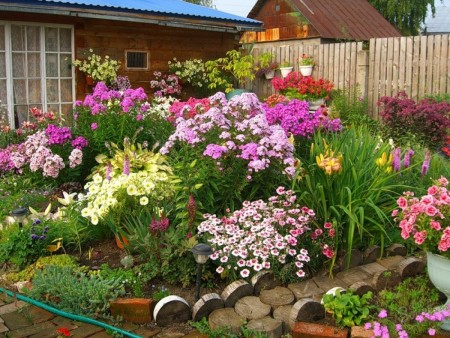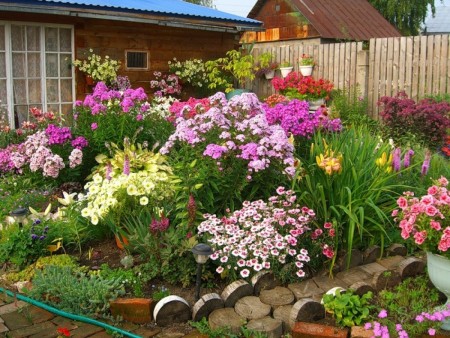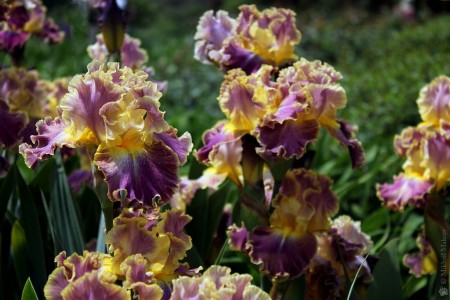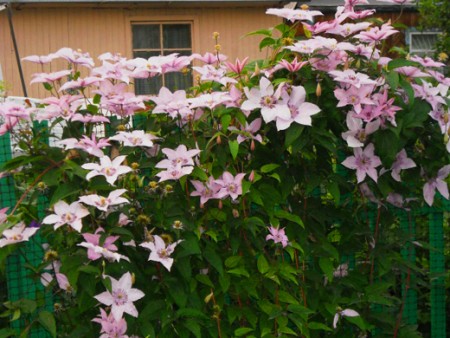As soon as perennials and bulbous plants begin to grow in the spring (which means their roots have begun to work), to activate vegetative growth they are given nitrogen fertilizers: for bulbous plants - 1-2 tbsp. spoons of urea, for perennials - 1 tbsp. spoon per sq. m.
A little later, during the first loosening of the soil, phosphorus and potassium fertilizers are applied (if they were not applied in the fall) - 2 tbsp. spoons of superphosphate and tbsp. spoon of potassium sulfate per sq. m.Perennials that are not growing actively enough can be fed with organic infusions (mullein, bird droppings, green grass).
Further feeding is associated with the flowering period of plants, when they are given complete mineral fertilizer, which contains nitrogen, phosphorus, potassium in a ratio of 1: 3: 2. During the period when the top layer of soil dries out quite quickly, it is better to apply fertilizers in dissolved form, combining fertilizing with watering.
But this is a very generalized scheme for feeding perennial plants, requiring specification for individual species.
TulipsHaving received nitrogen during the period of leaf growth, they need phosphorus-potassium nutrition during the budding phase: according to Art. spoon of superphosphate and potassium sulfate per square meter. m. During this period, you can still add 0.5 tbsp. spoons of urea per sq. m. During the flowering period and immediately after it, tulips are given only phosphorus and potassium fertilizers: according to Art. a spoonful of superphosphate and potassium sulfate. It is even better to use complex fertilizers with microelements for fertilizing. Boron and zinc are especially beneficial for tulips.
During budding, flowering and two weeks after flowering, tulips are regularly watered. When plants lack moisture, they form short peduncles and small flowers and quickly fade. Proper watering helps the bulbs accumulate enough nutrients and grow large and regular in shape.
On daffodils Do not get carried away with nitrogen fertilizers, otherwise the leaves will grow narrow and weak. It is better to use complex fertilizers before flowering: Art. spoon per 10 liters of water. During flowering, feed with phosphorus and potassium: 2 tbsp. spoons of superphosphate and tbsp. spoon of potassium sulfate per sq. m. After such feeding, the bulbs ripen better.
Almost the same menu at hyacinths.
Bearded irises fertilizing with complete mineral fertilizer (a tablespoon per sq. m) at the beginning of the growing season will help “be in shape” during the flowering period. The irises are fed again about three weeks after flowering, when new roots and rhizome links begin to grow, and flower buds are formed: according to Art. a spoonful of superphosphate and potassium sulfate.
The presence of nitrogen in fertilizing negatively affects the winter hardiness of plants. Irises do not need organic fertilizers: they contribute to the development of fungal and bacterial diseases.
Lilies in the spring they feed when they begin to grow: Art. spoon of complete mineral fertilizer per sq. m.
Phloxam It is advisable to add organic matter: a bucket of compost or humus for every 2-3 bushes.
Compost and humus will not hurt roses. To make the shoots grow more actively, feed them with an organic infusion (mullein, bird droppings or green grass): one bucket for 2-4 bushes (depending on the size and age of the plants).
Peony also loves organic fertilizers. You can add a bucket of good humus or compost under each mature bush. Later, during the budding period, we pour mullein infusion (1:10) into the peony into a groove made around the bush. After feeding, immediately water and fill the ditch.
Clematis We give fertilizers when they begin to actively grow: Art. a spoonful of complete fertilizer in a bucket of water, consumption - for 1-2 bushes. This top dressing can be replaced with mullein infusion - 1:10, adding tbsp. spoon of complete fertilizer. During the budding period, we feed with complex fertilizer.
Daylilies During the period of leaf growth, we feed with complex fertilizer, scattering it around the bushes and covering it with a hoe.
Korean chrysanthemums “push” with mullein infusion (1:20, consumption - a bucket per sq. m).
Delphinium forms a lush bush if in April you feed it with an organic infusion (1:10) or a complete mineral fertilizer with a predominance of nitrogen.
KhostamBefore they grow, it is advisable to add compost and humus. As a rule, this is enough to make the plants look decorative all season. Although one fertilizing with a solution of complex fertilizer will not cause harm.





 (8 ratings, average: 4,25 out of 5)
(8 ratings, average: 4,25 out of 5) CUCUMBERS NEVER GET SICK, I'VE BEEN USING ONLY THIS FOR 40 YEARS! I SHARE A SECRET WITH YOU, CUCUMBERS ARE LIKE THE PICTURE!
CUCUMBERS NEVER GET SICK, I'VE BEEN USING ONLY THIS FOR 40 YEARS! I SHARE A SECRET WITH YOU, CUCUMBERS ARE LIKE THE PICTURE! You can dig a bucket of potatoes from each bush. Do you think these are fairy tales? Watch the video
You can dig a bucket of potatoes from each bush. Do you think these are fairy tales? Watch the video
 How our fellow gardeners work in Korea. There is a lot to learn and just fun to watch.
How our fellow gardeners work in Korea. There is a lot to learn and just fun to watch. Eye trainer. The author claims that with daily viewing, vision is restored. They don't charge money for views.
Eye trainer. The author claims that with daily viewing, vision is restored. They don't charge money for views. A 3-ingredient cake recipe in 30 minutes is better than Napoleon. Simple and very tasty.
A 3-ingredient cake recipe in 30 minutes is better than Napoleon. Simple and very tasty. Therapeutic exercises for cervical osteochondrosis. A complete set of exercises.
Therapeutic exercises for cervical osteochondrosis. A complete set of exercises. Which indoor plants match your zodiac sign?
Which indoor plants match your zodiac sign? What about them? Excursion to German dachas.
What about them? Excursion to German dachas.